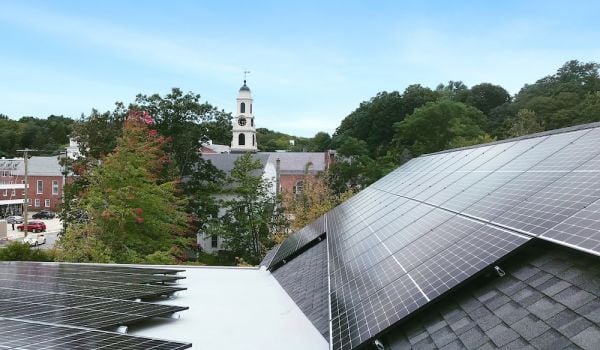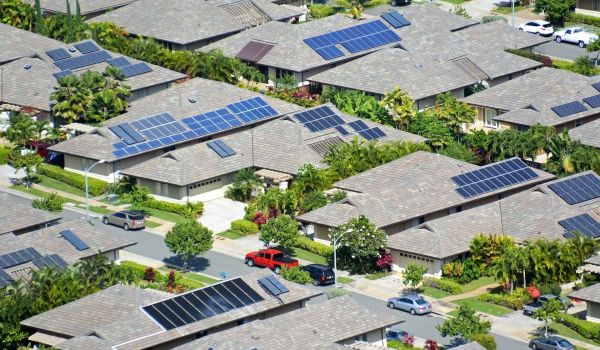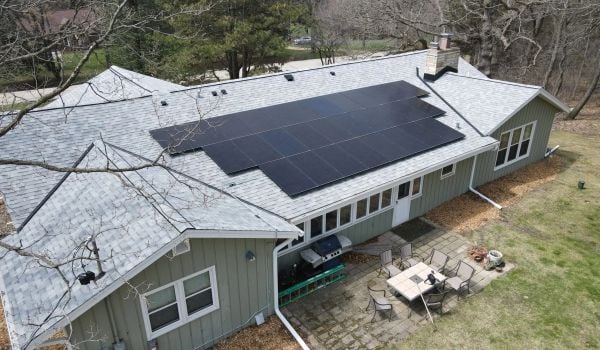School districts across the country have suffered from painful budget cuts this year. But as millions of children go back to school this fall, more than a few are getting assistance from what might at first seem an improbable source of education funding — the sun.
Perhaps no one is more impressed than Paul Kilkenny, who graduated from San Jose’s Silver Creek High School in 1979. When he returns these days, he often stops at a big screen TV in the administration building. There he watches a procession of statistics about kilowatts and the value of the electricity generated by his his alma mater.
Silver Creek is one of 13 schools in the East Side Union High School District that collectively generate millions of dollars in electric power from solar panels mounted in school parking lots, which also shade the cars of teachers and students. Created by a 2-year-old partnership between the district and Chevron Energy Solutions, a division of the oil giant, it is the largest K-12 solar and energy efficiency program in the U.S. and generates enough electricity to supply nearly 8,000 homes.
“This is profit,” Kilkenny says of the readouts, “and our kids can see this as the basis for an industry and a career. There are also some very profound fiscal considerations here for a school district that is always struggling with fiscal solvency.”
Begun in the depths of the recession when the district had lost more than 200 teaching positions, the project is a rare example of an investment of capital funds generating savings for a school district’s general fund. In just its first year of operation the project was credited with savings equivalent to 30 teaching jobs.
“Basically, through an investment of $25 million, we’re able to save the community taxpayers $43 million over the life of the project, and that is a considerable savings,” said Frank Biehl, president of the district board, whose two sons graduated from the district’s Evergreen Valley High. The savings come from buying less power from the grid, other energy efficiency aspects of the project, and selling surplus power to the grid.
Yet these encouraging numbers are not what interest Kilkenny most about the project.
As the district’s science curriculum coordinator, he works with the science faculty at all 11 of its comprehensive high schools. The “solar photovoltaic project,” as it’s officially called, is an ongoing experiment that classes study. The television — and each school has one — is simply a publicly visible part of the school district’s science teaching.
As part of its contribution to the partnership, Chevron provided a solar energy curriculum and energy technology kits containing functioning solar panels and electrical metering equipment. Science students can take the kits outside and do experiments, such as measuring the change in power production as they change the angle at which the panels face into the sun.
“These activities couldn’t be done any other way,” Kilkenny said. “We couldn’t afford to buy these kits. It’s impossible not to see the inequity when I travel to other districts and the quality of their materials and buildings.”
At 24,000 students, the district is the largest high school district in Northern California. But despite its location in the heart of Silicon Valley, it is also one of the poorest. Fewer than 9 percent of its students are white, and it offers an adult education program to an additional 8,100 students.
“Getting involved with their hands in science and seeing how solar power works has a real impact on students,” Kilkenny continued. “It’s something practical and quantifiable. If you can’t generate meaningful discussion around energy with these technology kits, you’re probably in the wrong profession as far as being a science teacher.”
East Side is one of three Santa Clara County school districts that have installed solar panels and received energy efficiency retrofits under the Chevron program. In 2011 the Morgan Hill Unified School District, in the rural southern part of the county, completed a solar project that provides 80 percent of the electricity demand for its two high schools. San Jose Unified School District began a two-phase solar project in 2007, which cut the energy costs at four of its six high schools by a third.
All of these projects were financed by a combination of state and federal incentives and capital improvement funds. As a result, together the three school districts will reduce carbon emissions by 6,800 tons each year — the amount absorbed by a 1,600-acre forest — and generate power sufficient to supply more than 15,000 homes.
The San Jose area solar projects are an example of clean infrastructure that also provides a social good, contributing to a better environment while inspiring the next generation of scientists. “It’s very important to invest the community’s money wisely,” Biehl said, “and this is an example of that type of project.”
Working Partnerships USA is a grantee of the Surdna Foundation.
The Works is made possible with the support of the Surdna Foundation.

















